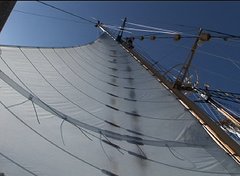 |
| Members of A and B watches stand on the quarterdeck in anticipation of the beginning of the line chase. |
Shortly after leaving French Polynesian waters--Kiribati here we come--we reached an important moment. It was, in a way, a test of all our previous nautical science learning. Hours of toil on land, many pots of coffee brewed to make it to nautical science at 8am sharp in the beautiful (and very familiar by the end of our five weeks taking classes there) Agassiz building at Hopkins Marine Station, sunburns earned after pantomiming setting and striking sails with Canadian geese and harbor seals looking on skeptically, knots-successful and unsuccessful-tied and undone and long periods studying diagrams of our faithful Brigantine the RCS, had prepared us for what was-for me at least-one of the most exciting moments of our journey thus far: turning off the main engine. WE WERE SAILING BABY.
After three or so days of motor sailing, during which we used our main and fore stay sails for balance, setting the squares was thrilling. It was also good incentive to learn not only the positions of the lines along the rails, but also their purposes in preparation for some healthy competition during our daily class session. Class onboard the RCS includes announcements and reports from different places around the ship: engineering, weather, navigation, science as well as more variable activities. Today's was the much anticipated line chase. A, B and C watches competed against each other to correctly locate each line and return to tag the next member of their watch in the relay. I have to take a moment to brag about my own A watch team-sporting some pretty rad colored mustaches courtesy of our TA and teammate Heidi-coming in well ahead of the rest of the competition. Thanks to lots of guidance from our watch leaders Chief Mate Ryan and Third Assistant Scientist Laura we're getting quicker and more comfortable setting and striking sails (which is a good sign since we'll need to lots more of that in the next month before reaching Honolulu).
Our triumph during the line chase is just one example of the way our classroom learning on shore translates to our daily lives on the ship. Even though Monterey seems far away, and there are certain things, like how to tend a sheet or steer by the stars rather than the compass at the helm or stay upright as the ship rolls while we are hove to on science station, things absolutely make more sense having learned some background on shore.
Our geology, biology and navigational backgrounds continue to come in handy for our next task: the great seamount hunt. Our fellow crewmember Emma, who wrote our first blog post from shore, is working on a project examining the effects of seamounts on the surrounding pelagic environment using a number of different metrics. Our cruise track passes almost directly over a line of little-known and little-studied seamounts. As a result, pinpointing their exact, or near exact locations has meant a number of jibing and tacking maneuvers-allowing us to practice sail handling-as well as having a set of eyes glued to the CHIRP sonar system in the RCS lab, which provides information about the sea floor surface bathymetry.
We successfully located and sampled at one seamount late yesterday evening and will hopefully do the same at another in the next hour or so. There's a tangible camaraderie tying the whole crew together, which means we all get excited about each other's project, offer to pour each other's iced tea at lunch and take things to one another's bunks during the day. We all do our part to make the RCS "sail for science." I like to think of the RCS as a self-contained, wind-driven, productive (and sweaty) utopia-which isn't something I've been able to say about any of my other classes at Stanford.
Thanks for reading and stay tuned for further updates on seamounts, Caroline and our small ship on the mighty Pacific.
Wishing you all fair winds,
-


1 comment:
Love the blogs! Thanks for bringing to life the sights sounds smells and educational bits of your great RCS adventure. The more details, the better!
Post a Comment